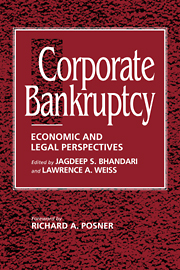Book contents
- Frontmatter
- Contents
- List of tables and figures
- Foreword by the HONORABLE RICHARD A. POSNER
- Preface
- Part I The role of credit
- Part II Bankruptcy as a reflection of the creditors' implicit bargain
- Part III Beyond the basic creditors' bargain
- 9 Bargaining after the fall and the contours of the absolute priority rule
- 10 On the nature of bankruptcy: An essay on bankruptcy sharing and the creditors' bargain
- 11 A simple noncooperative bargaining model of corporate reorganizations
- 12 Commentary on “On the nature of bankruptcy”: bankruptcy, priority, and economics
- 13 Bankruptcy and risk allocation
- 14 The corporate bankruptcy decision
- 15 Bargaining over equity's share in the bankruptcy reorganization of large, publicly held companies
- 16 Bankruptcy resolution: Direct costs and violation of priority of claims
- 17 The costs of conflict resolution and financial distress: Evidence from the Texaco-Pennzoil litigation
- 18 Survey of evidence on business bankruptcy
- Part IV Workouts or bargaining in the shadow of bankruptcy
- Part V Alternatives to bankruptcy and the creditors' bargain
- Part VI Experience of other countries
- Index
10 - On the nature of bankruptcy: An essay on bankruptcy sharing and the creditors' bargain
Published online by Cambridge University Press: 10 December 2009
- Frontmatter
- Contents
- List of tables and figures
- Foreword by the HONORABLE RICHARD A. POSNER
- Preface
- Part I The role of credit
- Part II Bankruptcy as a reflection of the creditors' implicit bargain
- Part III Beyond the basic creditors' bargain
- 9 Bargaining after the fall and the contours of the absolute priority rule
- 10 On the nature of bankruptcy: An essay on bankruptcy sharing and the creditors' bargain
- 11 A simple noncooperative bargaining model of corporate reorganizations
- 12 Commentary on “On the nature of bankruptcy”: bankruptcy, priority, and economics
- 13 Bankruptcy and risk allocation
- 14 The corporate bankruptcy decision
- 15 Bargaining over equity's share in the bankruptcy reorganization of large, publicly held companies
- 16 Bankruptcy resolution: Direct costs and violation of priority of claims
- 17 The costs of conflict resolution and financial distress: Evidence from the Texaco-Pennzoil litigation
- 18 Survey of evidence on business bankruptcy
- Part IV Workouts or bargaining in the shadow of bankruptcy
- Part V Alternatives to bankruptcy and the creditors' bargain
- Part VI Experience of other countries
- Index
Summary
Finance theorists have long recognized that bankruptcy is a key component in any general theory of the capital structure of business entities. Legal theorists have been similarly sensitive to the substantial allocational and distributional effects of the bankruptcy law. Nevertheless, until recently, underlying justifications for the bankruptcy process have not been studied widely. Bankruptcy scholars have been content to recite, without critical analysis, the two normative objectives of bankruptcy: rehabilitation of overburdened debtors and equality of treatment for creditors and other claimants.
The developing academic interest in legal theory has spurred a corresponding interest in expanding the theoretical foundations of bankruptcy law as well. One of us has developed, over the past several years, a conceptual paradigm, based on a hypothetical bargain among creditors, as a normative criterion for evaluating the bankruptcy system. The cornerstone of the creditors' bargain is the normative claim that prebankruptcy entitlements should be impaired in bankruptcy only when necessary to maximize net asset distributions to the creditors as a group and never to accomplish purely distributional goals.
The strength of the creditors' bargain conceptualization is also its limitation. The hypothetical bargain metaphor focuses on the key bankruptcy objective of maximizing the welfare of the group though collectivization. This single-minded focus on maximizing group welfare helps to identify the underlying patterns in what appear to be unrelated aspects of the bankruptcy process. It also implies that other normative goals should be seen as competing costs of the collectivization process.
- Type
- Chapter
- Information
- Corporate BankruptcyEconomic and Legal Perspectives, pp. 141 - 167Publisher: Cambridge University PressPrint publication year: 1996



